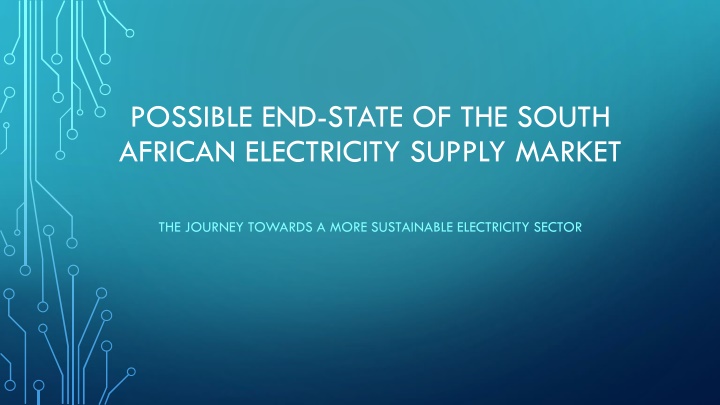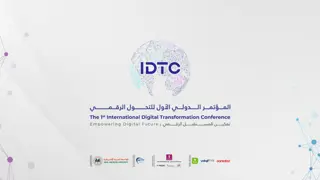Transformation of South African Electricity Market: Towards Sustainability
The South African electricity supply market is undergoing significant changes to establish a more sustainable sector. The journey involves unbundling Eskom into separate entities for generation, transmission, and distribution. Regulatory reforms are being implemented to create a competitive electricity market aimed at enhancing efficiency and reducing prices. The current state of the industry showcases challenges faced by Eskom, emphasizing the need for swift action to safeguard economic and social development ambitions. Objectives include increasing efficiencies and ensuring a more reliable power supply for South Africa's future growth.
Download Presentation

Please find below an Image/Link to download the presentation.
The content on the website is provided AS IS for your information and personal use only. It may not be sold, licensed, or shared on other websites without obtaining consent from the author.If you encounter any issues during the download, it is possible that the publisher has removed the file from their server.
You are allowed to download the files provided on this website for personal or commercial use, subject to the condition that they are used lawfully. All files are the property of their respective owners.
The content on the website is provided AS IS for your information and personal use only. It may not be sold, licensed, or shared on other websites without obtaining consent from the author.
E N D
Presentation Transcript
POSSIBLE END-STATE OF THE SOUTH AFRICAN ELECTRICITY SUPPLY MARKET THE JOURNEY TOWARDS A MORE SUSTAINABLE ELECTRICITY SECTOR
CONTENT 1. 2. 3. 4. 5. 6. CURRENT STATE OF THE INDUSTRY OBJECTIVES OF UNBUNDLING & FORMATION OF ELECTRICITY MARKET CURRENT ROLE OF THE ENERGY REGULATOR REGULATORY REFORMS TO ESTABLISH THE ELECTRICITY MARKET ROLE OF REGULATION IN A REFORMED ELECTRICITY MARKET DUTIES OF A REGULATOR TO ENSURE INTEGRITY AND TRANSPARENCY IN THE MARKET 7. 8. 9. 10. CONCLUSIONS DUTIES OF A REGULATOR TO ENFORCE RULES EVOLVING POWER MARKET STRUCTURE PROPOSED MARKET STRUCTURE CAN PROVIDE NEEDED CAPACITY & ENERGY
1. CURRENT STATE OF THE INDUSTRY Eskom is in crisis and the risks it poses to South Africa are great. It could severely damage our economic and social development ambitions. We need to take bold and decisive action .To position South Africa s power sector for the future, we shall immediately embark on a process for establishing three separate entities Generation, Transmission, Distribution, under Eskom Holdings ..Of particular and immediate importance is the entity to manage an independent state-owned transmission grid combined with the system operator, and power planning, procurement and buying functions. It is imperative that we undertake these measures without delay SONA 7 February 2019
1. CURRENT STATE OF THE INDUSTRY Contingent liabilities
1. CURRENT STATE OF THE INDUSTRY 2007 2019 Total installed capacity (MW) 42,618 44,172 Shrinking Sales!! Electricity sales (GWh) 218,121 208,319 Revenue (R millions) 39,389 179,892 Average selling price (c/kWh) 18 86.4 Coal purchases (Mt) 117.4 113.8 Coal costs (R millions) 10,000 58,500 Employee costs (R millions) 9,451 33,272 Employee numbers (group) 32,674 46,665 Debt securities and borrowings (R millions) 40,455 440,610
2. OBJECTIVES OF UNBUNDLING & FORMATION OF ELECTRICITY MARKET Eskom has an installed generation capacity of approx. 46 000 MW, but can hardly produce more than 32 000 MW to meet system demand. This means that 14 000MW is unavailable at any given time, which is highly inefficient. The broad objectives of unbundling and introduction of a competitive market is to increase efficiencies and to drive prices down through competition.
2. OBJECTIVES OF UNBUNDLING & FORMATION OF ELECTRICITY MARKET The problems associated with the vertically integrated monopoly model can be summarised as inefficiencies, lack of transparency, corruption, utility death spiral & unsustainable bailouts. To surmount these problems the first step is to unbundle the vertically integrated monopoly through legal separation by establishing a separate Transmission System & Market Operator (TSMO) This will progressively establish a transparent, fair platform for competitive procurement of least-cost power.
2. OBJECTIVES OF UNBUNDLING & FORMATION OF ELECTRICITY MARKET This will set the industry on a new path towards a fully competitive market enabling private sector investment. The broad objectives of unbundling and introduction of a competitive market is to solve the Energy Trilemma of finding a balance between energy reliability, affordability and sustainability. In the case of South Africa, this requires a balancing act of prioritizing security of supply to eliminate load shedding while ensuring sustainability and affordability. Regulation has a significant role to play to ensure that the above objectives are realized.
3. CURRENT ROLE OF THE ENERGY REGULATOR Below is a summary of the duties & powers of the Energy Regulator as defined in Sections 4 (i) (vii) of the Electricity Regulations Act: consider applications and issue licenses for Gx, Tx and Dx facilities, import & export of electricity and trading regulate prices & Tariffs register persons who are not required to hold a license issue rules designed to implement the national government electricity policy framework enforce performance and compliance, and take appropriate steps in the Case of non-performance.
4. REGULATORY REFORMS TO ESTABLISH THE ELECTRICITY MARKET The ERA amendment bill introduces regulatory reforms and establishes a separate system and market operator and is currently undergoing parliamentary processes. Section 4 of the ERA amendment bill adds the following duties for the Regulator: consider applications and issue licenses to the market operator or system operator . Sections 34A & B of the ERA amendment bill further establishes the Market Operator and the Central Purchasing Agency
4. REGULATORY REFORMS TO ESTABLISH THE ELECTRICITY MARKET The bill defines the high-level requirements for the market. A Market Code shall be crafted as a secondary legislative instrument by the Market Operator (subject to article 34B (3)(b)) to define the details of the operation of the market as well as the market operator functions including the required trading platform(s). The Energy Regulator will approve the Market Code and ensure that it fulfils the objectives that it is intended according to article 34B (3)(b).
4. REGULATORY REFORMS TO ESTABLISH THE ELECTRICITY MARKET
5. ROLE OF REGULATION IN A REFORMED ELECTRICITY MARKET The formation of Market structure does not mean de-regulation but re-regulation. Regulators need to implement strict Regulations on wholesale markets to ensure integrity and transparency in market transactions. It is the duty of the regulator to ensure integrity and transparency because potential market entrants want to see an electricity market with integrity and transparency.
5. ROLE OF REGULATION IN A REFORMED ELECTRICITY MARKET To ensure open, transparent and well-functioning electricity market, the regulator should: Continuously monitor the markets Enforce publication of pertinent information by utilities Enforce against market manipulation and insider trading With regards to tariffs, regulators should not design nor set tariffs, but approve the terms and conditions governing the tariffs that the system operators (DSO and TSO) submit for regulatory approval
5. ROLE OF REGULATION IN A REFORMED ELECTRICITY MARKET The criteria for regulatory approval of tariffs should ensure that tariffs are: cost-reflective transparent non-discriminatory fair Where the market structure permits, energy prices must be determined by the market mechanism.
5. ROLE OF REGULATION IN A REFORMED ELECTRICITY MARKET Where it is necessary to regulate prices because of the nature of the energy services, such as electricity distribution, which is by nature a virtual monopoly, the regulator should ensure efficient pricing and a fair return on assets. Electricity tariffs in regulated areas should reflect the cost of supply and the costs should be efficient. In addition, the consumer tariffs must meet the social equity objective of affordability for the under-privileged members of the population.
6. DUTIES OF A REGULATOR TO ENSURE INTEGRITY AND TRANSPARENCY IN THE MARKET License/register Market Participants Monitor market transactions Ensure that Market participants publish inside information Ensure that Market participants abstain from insider trading and market manipulation Survey the market
7. DUTIES OF A REGULATOR TO ENFORCE RULES The choice of enforcement tool used should be governed by the principle of proportionality. Possible enforcement tools: Stressing the legislation in place (issuance of notification of non-compliance stressing adherence to legislation) Indictment in case of a breach (notification of a breach) Order in case of a breach (Administrative fines can be imposed to ensure compliance Handover to public prosecutors (revocation of license for serious criminal offences)
8. EVOLVING POWER MARKET STRUCTURE Proposed Power Market Structure Current Structure Future Market Structure *Proposed includes rural electrification authorities that purchase electricity in bulk from the NTCSA and sell at subsidized and regulated retail prices
9. PROPOSED MARKET STRUCTURE CAN PROVIDE NEEDED CAPACITY & ENERGY
10. CONCLUSIONS Eskom will not be able to keep the lights on its current form. Eskom needs to be unbundled and an establishment of TSO will facilitate new power investments Regulatory reforms are needed to support the functions of a proper electricity market Transitioning from a vertically integrated monopoly to a market, will help to solve the Eskom crises, provide needed investment in the sector and also solve economic and socio-economic issues.























